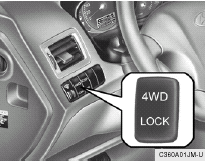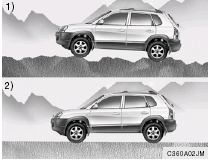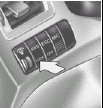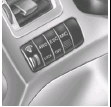 Hyundai Tucson: 4WD lock system
Hyundai Tucson: 4WD lock system
 4WD lock system (With Electronic Control 4WD) (If installed)
4WD lock system (With Electronic Control 4WD) (If installed)
This 4WD system is designed for dividing the power ratio automatically in normal driving conditions. During off-road or low-friction driving conditions, press the 4WD lock button to drive in fulltime 4WD, dividing the power ratio to 50:50 in the front and rear wheels. The 4WD lock indicator light in the instrument cluster is illuminated. This setup begins to get cancelled when the vehicle speed exceeds 30 km/h, and the function is completely released at a speed of 40 km/ h or higher. Conversely, the function is rerun when the speed again drops to 40 km/h or lower, and is fully established at speeds below 30 km/ h. To release the 4WD lock function, press the 4WD lock button again. The 4WD lock indicator light in the instrument cluster should go off.

1) Pressing the 4WD lock button on the tough terrain, the driving power is equally distributed to the front and rear. 4WD lock keeps activating when not exceeding 40 km/h. 2) Release the 4WD lock button on the normal driving conditions.
Four Wheel Drive (4WD) transfer mode selection
| Transfer mode | Selection button | Indicator light | Description |
| 4WD LOCK |
 |
 (Indicator light is
illuminated)
(Indicator light is
illuminated) |
o This mode is used for climbing or descending sharp grades, off-road driving, driving on sandy and muddy roads etc. to maximize traction. o This mode automatically begins to deactivate at speed above 19 mph (30 km/h) and is shifted to 4WD AUTO mode at speed above 25 mph (40 km/h). If the vehicle decelerates to speeds below 19 mph (30 km/ h), however, the transfer mode is shifted into 4WD LOCK mode again. |
| 4WD AUTO (4WD LOCK is deactivated) |
 |
(Indicator light is not illuminated) | o When driving in AUTO mode, the vehicle operates similar to the conventional 2WD vehicles under normal operating conditions. However, if the system determines that there is a need for the 4WD mode, the engine’s driving power is distributed to all four wheels automatically without driver intervention. o When driving on normal roads and pavement, the vehicle moves similar to the conventional 2WD vehicles. |
NOTE: o When driving on normal roads, deactivate the 4WD LOCK mode by pushing the 4WD LOCK button(the indicator light goes off). Driving on normal roads with 4WD LOCK mode(especially, when cornering) may cause mechanical noise or vibration. The noise and vibration will disappear when the 4WD LOCK mode is deactivated. Some parts of the power train may be damaged by prolonged driving with the noise and vibration. o When the 4WD LOCK mode is deactivated, a shock may be felt as the drive power delivered entirely to the front wheels. This shock is not a mechanical failure.
 Full-time 4WD operation
Full-time 4WD operation
(If installed)
Engine power can be delivered to all wheels.
Full-time 4WD is useful when good traction is
required, such as, when driving on slippery, wet
or snow-covered roads and when moving ...
 Good braking practices
Good braking practices
WARNING:
o Whenever leaving vehicle or parking,
always set the parking brake as far as
possible and fully engage the vehicle's
transaxle into the park position. Vehicles
not fully engaged in ...
See also:
Cargo shade (if equipped)
If your vehicle has a cargo shade, you can use it to cover items in the
cargo area of your vehicle.
To install the shade:
• Insert the ends of the cargo
shade into the mounting features
loc ...
Applicable warranties – U.S./Canada
In accordance with applicable U.S. and Canadian
regulations, the following list of warranties
is provided.
• New Vehicle Limited Warranty
• Parts and Accessories Limited Warranty
• Corros ...
When does BLIS function
The system functions when your vehicle is
moving at speeds above 6 mph (10 km/h).
When you pass another vehicle:
The system reacts when you pass another
vehicle at a speed of up to 6 mph (10 km/ ...
